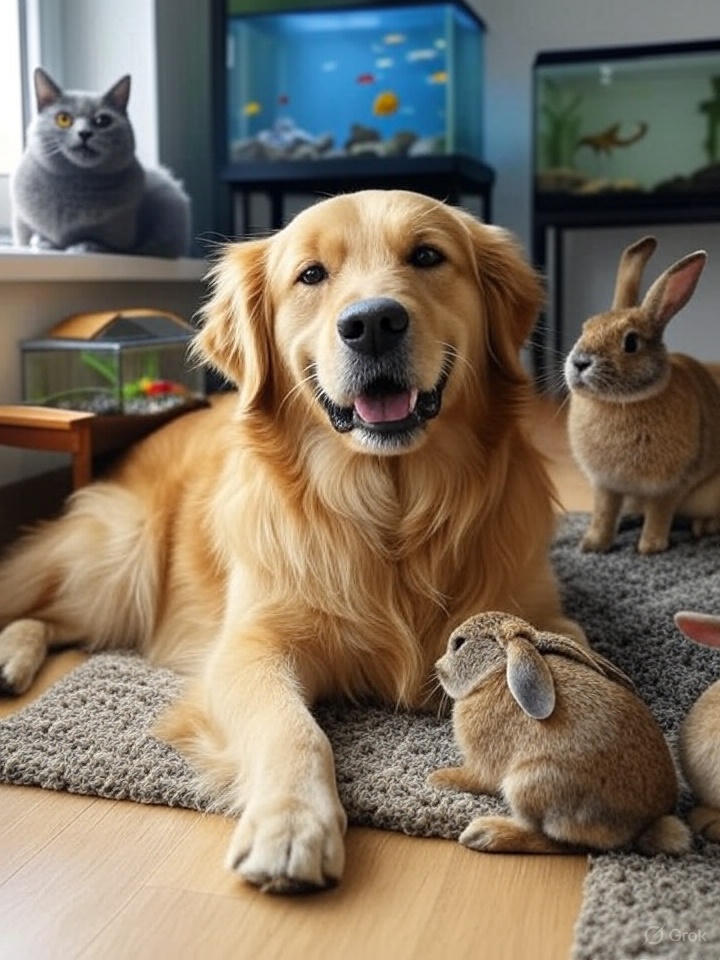Bringing a pet into your home is one of life’s most rewarding experiences. Whether you’re a first-time pet owner or looking to add another furry, feathered, or scaled friend to your family, the decision to welcome a pet into your home requires careful consideration, preparation, and commitment. This comprehensive guide will walk you through everything you need to know about pets for homes, from choosing the right companion to creating a loving, supportive environment that benefits both you and your new family member.
Understanding the Human-Pet Bond
The relationship between humans and pets has evolved over thousands of years, creating what scientists call the human-animal bond. According to the American Veterinary Medical Association, this bond is a mutually beneficial and dynamic relationship between people and animals that is influenced by behaviors essential to the health and wellbeing of both. This connection goes far beyond simple companionship—it encompasses emotional, psychological, and even physical health benefits that can transform lives.
Research conducted by institutions like Harvard Medical School has consistently shown that pet ownership can reduce stress, lower blood pressure, decrease feelings of loneliness, and even boost immune system function. The simple act of petting a dog or cat releases oxytocin, often called the “love hormone,” which promotes feelings of happiness and reduces cortisol levels associated with stress.
Choosing the Right Pet for Your Home

Selecting the perfect pet for your home isn’t just about falling in love with an adorable face—it’s about finding a companion whose needs align with your lifestyle, living situation, and long-term commitment capabilities. The process requires honest self-assessment and thorough research into different species and breeds.
Assessing Your Lifestyle
Before visiting shelters or breeders, take a comprehensive look at your daily routine, living space, and future plans. Consider your work schedule, activity level, travel frequency, and family dynamics. A high-energy Border Collie might be perfect for an active family with a large yard, but could become destructive in a small apartment with owners who work long hours.
According to Forbes lifestyle experts, successful pet ownership begins with realistic expectations about time, energy, and financial commitments. Dogs typically require 1-3 hours of daily attention, including walks, feeding, and social interaction, while cats may need 30 minutes to an hour of interactive play and care.
Popular Pet Options for Homes
Dogs: The Ultimate Companions
Dogs remain America’s most popular pets, with over 90 million dogs living in U.S. households according to the American Pet Products Association. Their loyalty, trainability, and diverse range of sizes and temperaments make them suitable for various living situations. From tiny Chihuahuas perfect for apartment living to gentle giants like Great Danes who can thrive in larger homes, there’s a dog breed for almost every lifestyle.
Cats: Independent Yet Affectionate
Cats offer the perfect balance of companionship and independence, making them ideal for busy professionals or those who appreciate a more low-maintenance pet relationship. With over 94 million cats in American homes, these graceful creatures provide stress relief through their purring, which has been scientifically proven to have therapeutic effects on human health.
Small Mammals: Compact Companions
Rabbits, guinea pigs, hamsters, and ferrets offer pet ownership experiences in smaller packages. These animals can be incredibly social and interactive while requiring less space than dogs or cats. However, they still need daily attention, proper nutrition, and veterinary care to thrive.
Birds: Intelligent and Social
From cheerful canaries to talkative parrots, birds bring music and personality to homes. Many species are highly intelligent and can form strong bonds with their owners, some even learning to mimic speech and perform tricks.
Fish: Peaceful and Therapeutic
Aquarium keeping has been shown to reduce stress and anxiety while providing a beautiful focal point for any room. From simple goldfish bowls to elaborate reef tanks, fish keeping can be as simple or complex as desired.
Reptiles and Amphibians: Unique and Fascinating
For those seeking something different, reptiles and amphibians offer unique pet ownership experiences. Bearded dragons, geckos, and ball pythons can be surprisingly interactive and require specialized but manageable care routines.
Preparing Your Home for a New Pet
Creating a pet-friendly environment is crucial for both safety and comfort. This preparation phase sets the foundation for a successful transition and helps prevent common problems that new pet owners face.
Safety First: Pet-Proofing Your Space
Pet-proofing involves identifying and eliminating potential hazards throughout your home. Common dangers include toxic plants (like lilies for cats or chocolate for dogs), small objects that could be swallowed, electrical cords that might be chewed, and household chemicals that should be stored securely.
The ASPCA provides comprehensive lists of toxic substances and plants that should be kept away from pets. Creating designated safe spaces where your pet can retreat when feeling overwhelmed or tired is equally important.
Essential Supplies and Equipment
Every pet requires specific supplies to meet their basic needs. For dogs and cats, this includes food and water bowls, appropriate bedding, toys for mental stimulation, grooming supplies, and identification tags or microchips. The initial setup cost can range from $200-$1,000 depending on the type and size of pet, according to consumer reports from various pet industry sources.
Creating Comfortable Spaces
Pets need their own spaces within your home where they feel secure and comfortable. This might be a cozy bed in a quiet corner for a cat, a crate that serves as a den for a dog, or a properly equipped habitat for smaller animals. The key is providing areas where pets can rest undisturbed and feel safe.
The Health and Wellness Foundation

Maintaining your pet’s health requires proactive veterinary care, proper nutrition, and attention to behavioral and emotional needs. Establishing a relationship with a qualified veterinarian should be among your first priorities as a new pet owner.
Veterinary Care Essentials
Regular veterinary checkups, vaccinations, parasite prevention, and dental care form the foundation of pet health. Most pets require annual examinations, with senior animals needing more frequent visits. Emergency veterinary funds should also be considered, as unexpected medical costs can range from hundreds to thousands of dollars.
According to data from veterinary associations, preventive care is significantly more cost-effective than treating advanced diseases. Spaying and neutering, when appropriate, not only prevent unwanted litters but also reduce the risk of certain cancers and behavioral problems.
Nutrition: Fueling Health and Longevity
Proper nutrition plays a crucial role in pet health, affecting everything from coat condition to immune system function. High-quality commercial pet foods formulated for specific life stages typically provide balanced nutrition, but understanding ingredient labels and avoiding harmful additives is important.
WebMD’s Pet Health section offers evidence-based information about pet nutrition, helping owners make informed decisions about their pets’ diets. Obesity is a growing problem among pets, with over 50% of dogs and cats being overweight or obese, leading to numerous health complications.
Exercise and Mental Stimulation
Physical exercise and mental stimulation are vital for pet wellbeing. Dogs need daily walks and playtime, while cats benefit from interactive toys and climbing structures. Even smaller pets like rabbits and birds require opportunities for natural behaviors and exercise.
Mental stimulation is equally important and can be provided through puzzle toys, training sessions, and environmental enrichment. Bored pets often develop destructive behaviors, while mentally stimulated animals are generally happier and healthier.
Building Strong Relationships Through Training and Socialization
The bond between pets and their families strengthens through positive interactions, consistent training, and proper socialization. These elements create well-adjusted pets who can confidently navigate their world while respecting household rules and boundaries.
Positive Reinforcement Training
Modern animal training emphasizes positive reinforcement techniques that reward desired behaviors rather than punishing unwanted ones. This approach builds trust between pets and owners while effectively teaching everything from basic commands to complex tricks.
Professional trainers and animal behaviorists, as referenced by organizations like the Association of Professional Dog Trainers, advocate for force-free training methods that respect the animal’s emotional wellbeing while achieving training goals.
Socialization: The Key to Confident Pets
Proper socialization during critical developmental periods helps pets become comfortable with various people, animals, environments, and experiences. For puppies and kittens, this window typically occurs between 3-14 weeks of age, though adult animals can also benefit from gradual, positive exposure to new experiences.
Well-socialized pets are less likely to develop fear-based behavioral problems and can more easily adapt to changes in their environment or routine.
Addressing Behavioral Challenges
Even the best-cared-for pets may occasionally exhibit behavioral problems. Common issues include excessive barking, inappropriate elimination, destructive chewing, or aggression. Understanding the root causes of these behaviors—whether they stem from medical issues, insufficient exercise, anxiety, or inadequate training—is crucial for developing effective solutions.
Many behavioral problems can be prevented or resolved through environmental modifications, increased exercise and mental stimulation, consistent training, and sometimes professional intervention from certified animal behaviorists.
The Economic Aspects of Pet Ownership
Understanding the financial commitment of pet ownership helps families budget appropriately and avoid situations where economic constraints negatively impact pet care. The lifetime cost of pet ownership varies significantly based on the type of animal, size, health status, and level of care provided.
Initial Costs and Ongoing Expenses
Initial expenses include adoption fees or purchase prices, basic supplies, initial veterinary care including vaccinations and spaying/neutering, and home preparation costs. These upfront investments typically range from $500-$2,000 depending on the type of pet.
Ongoing monthly expenses include food, routine veterinary care, grooming, pet insurance or emergency fund contributions, and replacement of worn toys and supplies. CNN’s financial experts estimate that dog owners spend $1,000-$3,000 annually per pet, while cat ownership typically costs $600-$1,500 per year.
Pet Insurance and Emergency Planning
Pet insurance has become increasingly popular as veterinary care becomes more sophisticated and expensive. Policies vary widely in coverage and cost, but can provide peace of mind and financial protection against major medical expenses.
For families who choose not to purchase insurance, establishing an emergency fund dedicated to pet care is essential. Unexpected veterinary bills can easily reach $5,000-$10,000 for serious conditions requiring surgery or extended treatment.
Special Considerations for Different Life Stages
Pet ownership experiences evolve as both pets and their families go through different life stages. Understanding these transitions helps maintain strong relationships and appropriate care throughout the pet’s lifetime.
Pets and Children: Growing Up Together
Pets can provide tremendous benefits for children, teaching responsibility, empathy, and providing companionship and emotional support. However, successful pet-child relationships require supervision, education about appropriate animal interaction, and age-appropriate participation in pet care.
Research published in developmental psychology journals shows that children who grow up with pets often develop stronger social skills and emotional intelligence. The key is matching pet choices with family dynamics and ensuring that both children and pets are safe and comfortable.
Senior Pets: Golden Years Care
As pets age, their needs change significantly. Senior animals may require modified diets, increased veterinary monitoring, joint support, and environmental accommodations for decreased mobility or sensory function.
The reward of caring for senior pets lies in the deep bond that has developed over years of companionship. Many older animals become even more affectionate and appreciative of gentle care during their golden years.
End-of-Life Considerations
One of the most difficult aspects of pet ownership is eventually saying goodbye to beloved companions. The grief experienced when pets die is real and significant, often comparable to losing a human family member.
Understanding the grieving process and having resources for support during these difficult times is important for all pet owners. For comprehensive guidance on navigating pet loss and the healing process, families can find valuable resources and support at this detailed guide to pet loss and healing, which offers practical advice and emotional support for those dealing with the loss of a beloved pet.
Creating Pet-Friendly Communities
The benefits of pets extend beyond individual homes to entire communities. Pet-friendly neighborhoods, businesses, and public spaces create environments where both pets and their families can thrive while contributing to community wellness and social connections.
The Role of Local Resources
Successful pet ownership is supported by community resources including veterinary clinics, pet supply stores, grooming services, training facilities, dog parks, and pet-friendly businesses. These resources create networks of support that enhance the pet ownership experience while building social connections among pet owners.
Responsible Pet Ownership in Communities
Being a responsible pet owner within a community means following local laws and regulations, cleaning up after pets in public spaces, ensuring pets are properly contained and supervised, and being considerate of neighbors who may not share your enthusiasm for animals.
Many communities have established pet etiquette guidelines that help maintain harmony between pet owners and non-pet owners while ensuring that public spaces remain welcoming for everyone.
The Future of Pet Ownership
Technology and changing social attitudes continue to shape the future of pet ownership. Innovations in veterinary medicine, pet care products, and our understanding of animal behavior and psychology are creating new opportunities for enhancing pet-human relationships.
Technological Advances
Smart pet products, telemedicine consultations with veterinarians, GPS tracking devices, and automated feeding systems are making pet care more convenient and effective. These technologies can help monitor pet health, ensure proper nutrition, and maintain connections between pets and their families even during work hours or travel.
Evolving Understanding of Animal Welfare
Our understanding of animal cognition, emotion, and welfare continues to evolve, leading to improved care standards and stronger recognition of pets as sentient beings deserving of respect and compassion. This evolution influences everything from housing design to veterinary care protocols to legal protections for animals.
Conclusion: The Lifelong Journey of Pet Companionship
Choosing to welcome pets into our homes represents the beginning of a journey filled with joy, challenges, learning, and profound companionship. The decision requires careful consideration of lifestyle, resources, and long-term commitment, but the rewards of successful pet ownership are immeasurable.
From the excited greeting at the end of a long day to the quiet comfort of a purring cat on a difficult evening, pets enrich our lives in countless ways. They teach us about unconditional love, living in the present moment, and finding joy in simple pleasures.
As we’ve explored throughout this guide, successful pet ownership is built on foundations of proper preparation, ongoing education, adequate resources, and genuine commitment to our animals’ wellbeing. Whether you’re considering your first pet or adding to an existing animal family, the key is matching the right pet with your unique situation while preparing to provide a lifetime of love, care, and companionship.
The journey of pet ownership isn’t always easy—it requires sacrifices, financial investment, and emotional resilience through both joyful times and difficult periods. However, for millions of families around the world, the presence of beloved pets transforms houses into homes and creates memories that last long after our companions have crossed the rainbow bridge.
By choosing pets for our homes thoughtfully and caring for them responsibly, we not only enrich our own lives but contribute to a more compassionate world where the human-animal bond continues to flourish and evolve for generations to come.
For additional resources on pet care, training, and wellness, consult with local veterinarians, certified animal behaviorists, and reputable pet care organizations in your community.




